|
|
|
| My Favourite Planet > English > Europe > Greece > Macedonia > Stageira & Olympiada |
| Stageira & Olympiada |
History of Stageira & Olympiada - Part 4 |
|
 |
page 5 |
 |
|
| |

The Classical walls of Stageira's acropolis, around 500 BC. See Ancient Stageira gallery pages 8-17. |
| |
History of Ancient Stageira - Part 4
The Persian invasions, 514 - 479 BC |
| |
The modest economic success of Stageira led to an increase in the population, and about 500 BC the city and its walls had to be extended to the South Hill, which was dominated by the fortified area known as the acropolis (see Ancient Stageira gallery pages 8-17).
The new fortifications may have been substantial enough to deter opportunistic raids or attacks, but would have been no match for the enormous Persian armies which were about to sweep through northern Greece.
The Persian king Cyrus the Great had defeated Croesus of Lydia in 547 BC and expanded the Persian Empire to control the Greek cities of Asia Minor.
In 514-513 BC Megabazos, a general of Darius I (another Great), conquered Thrace, which later managed to free itself temporarily from Persian control during the Ionian Revolt by the Greeks of Asia (499-494 BC).
The expansion of Stageira and the building of its new walls therefore probably began between the time of Darius' conquest of Thrace and the Ionian Revolt.
The first Persian invasion of Greece, 492-490 BC
Following the involvement of Athens and Eretria in the Ionian Revolt, Darius sent an expedition under his son-in-law Mardonius in 492 BC to reconquer Thrace and reduce Macedonia to a client kingdom. Halkidiki must also have been under Persian control by this time, as Herodotus tells that "all the country as far as Thessaly had been enslaved and was tributary to the [Persian] King, by the conquests of Megabazus and Mardonius after him". [21]
However, when Mardonius' fleet attempted to round the Athos peninsula (then known as Ἀκτὴ, Akte), on its way to conquer Eretria and Athens, it was destroyed by a storm. [22]
In 490 BC Darius invaded Greece again with a fleet carrying an army of 20,000 men, which captured Naxos and other Aegean islands, destroyed Eretria, then headed for Marathon, on the east coast of the Attic peninsula, near Athens. At the Battle of Marathon the Persian force were met and defeated by a joint Greek army of 30,600. |
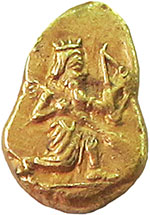
Persian gold daric,
5th - 4th century BC.
See Big Money at
The Cheshire Cat Blog. |
| |
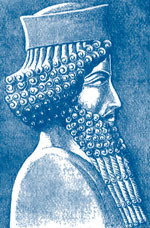
Darius I (550-486 BC)
[source] |
| |
| |
The second Persian invasion, 483-479 BC
Darius' successor Xerxes I (Ξέρξης, yet another Great, 519-465 BC) learned from the Athos naval catastrophe, and when planning his invasion of Greece seven years later, he decided to dig a canal across the isthmus north of the Athos peninsula (see map 5 and map 7 in History part 8).
Work on the canal began around 483 BC, and in 480 BC Xerxes marched his enormous army along the east Halkidiki coast, past Stageira to Akanthos, where he set up camp to inspect the canal and make final preparations for his invasion of Greece. According to Herodotus, this was the biggest army ever known. [23] The inhabitants of the local towns had to house and feed this enormous mass of people, which literally forced them "out of house and home" and ruined many of them financially. Xerxes also pressed the local men into his army: those from the coast to serve in his fleet, and those from inland to join the overland march to Athens. [24]
So, the situation at Stageira around 480 BC was grim. Having surrendered without a struggle, it was now occupied by the soldiers and camp followers of Xerxes' multi-national army, who lived at the expense of their hosts and helped themselves to their valuables. The men of the city, and whatever ships it possessed, were conscripted into the Persian king's campaign to conquer Athens and the rest of Greece.
But it seems that even this situation had its positive aspects: the roads that Xerxes built along the route of his march to Athens were much prized by locals for generations after. [24] (See map 5 and map 6 in History part 8.)
Eventually Xerxes' forces headed south through mainland Greece, where they were to meet their first serious opposition in the late summer of 480 BC. His land army wiped out the small Greek force under King Leonidas of Sparta at the mountain pass of Thermopylae, continued on through Boeotia and captured Athens. Meanwhile, after the naval Battle of Artemesium, off the north coast of Euboea, the Greek navy withdrew to the island of Salamis, in the Saronic Gulf opposite Athens.
It was at the Battle of Salamis that the allied Greeks managed to defeat the Persian fleet, with a great deal of courage and much subterfuge. Xerxes retreated to Asia, leaving his general Mardonius in charge of part of his army. Mardonius was defeated by the Greeks at the Battle of Plataea in 479 BC, and at the same time the rest of the Persian fleet was destroyed in the Battle of Mykale in Ionia, opposite the island of Samos. |
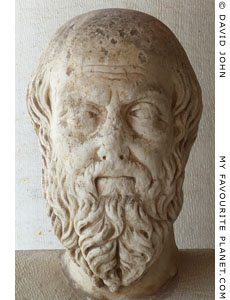
Marble head of Herodotus.
2nd century AD.
Agora Museum, Athens.
Inv. no. S 270. |
| |
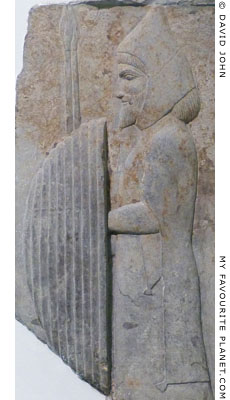
Warrior from Thrace ("the land
of Skudra") pays tribute to the
Persian king. From a relief from
Susa, Persia. Early 5th century BC.
Pergamon Museum, Berlin. |
| |
| |
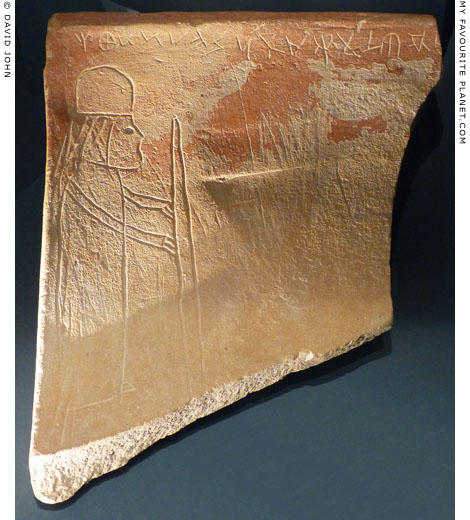
Graffito on a fragment of a ceramic roof tile thought to be evidence
of the presence of the Persian army in Central Macedonia in the early
5th century BC. A figure in oriental dress, wearing a rounded head
covering (according to the museum labelling "a tiara") and holding a
spear or sceptre, above which is an inscription in an alphabet (or
alphabets) used by the peoples of the Persian Empire who took
part in Xerxes' military campaign against Greece.
One of two pottery similar sherds (see the other below) found
in the 1980s at Toumba (ancient Therme, Θέρμη), Thessaloniki.
This sherd was handed in by a local resident.
Thessaloniki Archaeological Museum.
|
According to Herodotus (Histories, Book 7, chapters 121-124), the enormous army of Xerxes, consisting of peoples from around the Persian Empire, camped in the area of Therme for a few weeks (late August 480 BC) before moving on through central Greece towards Athens.
Thirty years after the fragments were discovered, the inscriptions have yet to be published or translated, and the script, which includes characters apparently from the Greek, Aramaic, Carian and Phoenician alphabets as well as unknown symbols, has not been identified. Perhaps they may prove to be the type of nonsense inscriptions known from some ancient Greek vases.
See: Eurydice Kefalidou, Strangers in a strange land: Two soldiers' graffiti from Ancient Thermi. An abstract (in Greek and English) of a paper on the two ceramic fragments, delivered at the Tenth Archaeological Symposium: Fieldwork and Research X, National and Kapodistrian University of Athens, 22-23 April 2015. Symposium Programme, pages 34-35. |
|
|
| |
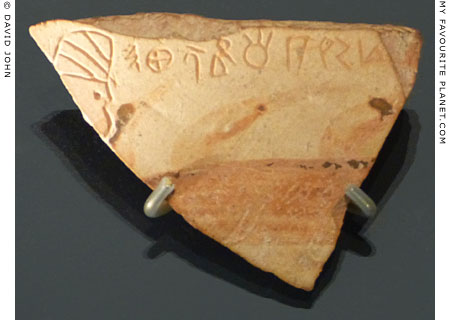
The other ceramic fragment with a Persian graffito found at
Toumba: a sherd of a local painted vase, excavated in 1986.
Thessaloniki Archaeological Museum. |
| |
Stageira &
Olympiada
History
part 4 |
Notes, references and links |
 |
|
21. Herodotus on the Persian conquest of Thrace and Macedonia
Herodotus (Greek: Ἡρόδοτος, circa 484 - circa 425 BC), "the Father of History", Greek historian born in Halicarnassus, Caria (modern day Bodrum, Turkey). His work Histories (ἱστορία, Istoría, which in Ancient Greek meant Inquiries), written in Ionic Greek around 460-420 BC, is the account of the wars between the Persians and the Greeks, but also includes historical and geographical background information, mentions of myths, legends, oracles and anecdotes.
"Their fleet subdued the Thasians, who did not so much as lift up their hands against it; their land army added the Macedonians to the slaves that they had already, for all the nations nearer to them than Macedonia had been made subject to the Persians before this."
Herodotus, The Histories, Book 6, chapter 44, section 1. Translated by A. D. Godley. Harvard University Press, 1920. At Perseus Digital Library.
"From Doriscus Xerxes went on his way towards Hellas, compelling all that he met to go with his army. As I have shown earlier, all the country as far as Thessaly had been enslaved and was tributary to the [Persian] king, by the conquests of Megabazus and Mardonius after him."
Herodotus, The Histories, Book 7, chapter 108. At Perseus Digital Library.
22. Herodotus on the Persian naval catastophe at Athos 492 BC
"Crossing over from Thasos they travelled near the land as far as Acanthus, and putting out from there they tried to round Athos. But a great and irresistible north wind * fell upon them as they sailed past and dealt very roughly with them, driving many of their ships upon Athos.
It is said that about three hundred ships were lost, and more than twenty thousand men. Since the coasts of Athos abound in wild beasts, some men were carried off by beasts and so perished; others were dashed against the rocks; those who could not swim perished because of that, and still others by the cold."
Herodotus, The Histories, Book 6, chapter 44, sections 2-3. Translation by A. D. Godley. Harvard University Press, 1920. At Perseus Digital Library.
* Northern Greece is still subject all year round to sudden violent storms, brought from the Balkan mountains to the north, and reaching as far south as Thessaly. In February 2012 the coast around the Strymonic Gulf was hit by storms and enormous waves which caused damage to several villages.
See also comments on the climate of northern Greece at The Cheshire Cat Blog:
Do Meteora dogs dream of floating sheep?
and
Desperately seeking summer part 2.
In other translations of this passage by Herodotus, the "wild beasts" around the coast of Athos are called "monsters" (George Rawlinson), "sea monsters" (G. C. Macaulay, 3rd edition, 1914) or even specifically named as "sharks that infest the sea around Mount Athos" (Robin Waterfield, Oxford University Press, 1998). Although sharks appear to be the only possible candidates for the "sea monsters" in the northern Aegean, it seems unlikely that there would have been sufficient numbers in the stormy sea to have killed scores or even hundreds of men. I have often seen dolphins along this coast, but never a shark, nor have I heard mention of anybody seeing one. Perhaps they were much more common in antiquity.
As for wild beasts on land, if another report by Herodotus is true, lions were numerous enough around Halkidiki to cause problems for Xerxes' enormous army in 480 BC as it marched from Akanthos to Therme (Θέρμη, southeast of where Thessaloniki was later to be founded, see History of Stageira Part 6) and the mouth of the river Axios (Ἄξιος) on the north coast of the Thermaic Gulf (see photo on Macedonia page 3):
"So the fleet lay there off the river Axius and the city of Therma and the towns between them, awaiting the king. But Xerxes and his land army marched from Acanthus by the straightest inland course, making for Therma. Their way lay through the Paeonian and the Crestonaean country to the river Cheidorus, which, rising in the Crestonaean land, flows through the Mygdonian country and issues by the marshes of the Axius.
As Xerxes marched by this route, lions attacked the camels which carried his provisions; nightly they would come down out of their lairs and made havoc of the camels alone, seizing nothing else, man or beast of burden. I wonder what prevented the lions from touching anything but the camels, creatures which they had not seen and had no knowledge of until then.
In these parts there are many lions and wild oxen, whose horns are those very long ones which are brought into Hellas. The boundary of the lions' country is the river Nestus which flows through Abdera and the river Achelous which flows through Acarnania. Neither to the east of the Nestus anywhere in the nearer part of Europe, nor to the west of the Achelous in the rest of the mainland, is any lion to be seen, but they are found in the country between those rivers."
Herodotus, The Histories, Book 7, chapters 124-126. |
|
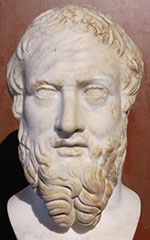
Marble head of Herodotus.
Roman period copy,
2nd century AD, of a 4th
century BC Greek original.
Neues Museum, Berlin.
Inv. No. Sk 295.
photo: © David John
See an illustrated profile
of Herodotus
in our People section. |
|
23. Herodotus on the size of Xerxes' army 480 BC
"This was by far the greatest of all expeditions that we know of. The one that Darius led against the Scythians is nothing compared to it; neither is the Scythian expedition when they burst into Media in pursuit of the Cimmerians and subdued and ruled almost all the upper lands of Asia (it was for this that Darius afterwards attempted to punish them). According to the reports, the expedition led by the sons of Atreus against Troy is also nothing by comparison; neither is the one of the Mysians and Teucrians which before the Trojan war crossed the Bosphorus into Europe, subdued all the Thracians, and came down to the Ionian sea, marching southward as far as the river Peneus."
Herodotus, The Histories, Book 7, chapter 20, section 2. At Perseus Digital Library.
24. Herodotus on Xerxes in Halkidiki 480 BC
Herodotus, The Histories, Book 7:
Chapter 115
"1. Journeying from the Strymon, the army passed by Argilus, a Greek town standing on a stretch of coast further westwards; the territory of this town and that which lies inland of it are called Bisaltia.
2. From there, keeping on his left hand the gulf off Poseideion [the Strymonic Gulf], Xerxes traversed the plain of Syleus (as they call it), passing by the Greek town of Stagirus, and came to Acanthus. He took along with him all these tribes and those that dwelt about the Pangaean range, just as he did those previously mentioned, the men of the coast serving in his fleet and the inland men in his land army.
3. The entire road along which king Xerxes led his army the Thracians neither break up nor sow, but they hold it in great reverence to this day."
Chapter 116
"When Xerxes came to Acanthus, he declared the Acanthians his guests and friends, and gave them Median clothing, praising them for the zeal with which he saw them furthering his campaign, and for what he heard of the digging of the canal."
. . .
Chapter 118
"But the Greeks who received Xerxes' army and entertained the king himself were brought to such a degree of misery [financial ruin], that they were driven from house and home. Witness the case of the Thasians, who received and feasted Xerxes' army on behalf of their towns on the mainland; Antipatrus son of Orgeus, as notable a man as any of his townsmen, chosen by them for this task, rendered them an account of four hundred silver talents expended on the dinner."
Chapter 119
"1. Similar accounts were returned by the officers in the other towns. Now the dinner, about which a great deal of fuss had been made and for the preparation of which orders had been given long ago, proceeded as I will tell.
2. As soon as the townsmen had word from the herald's proclamation, they divided corn among themselves in their cities and all of them for many months ground it to wheat and barley meal; moreover, they fed the finest beasts that money could buy, and kept landfowl and waterfowl in cages and ponds, for the entertaining of the army. They also made gold and silver cups and bowls and all manner of service for the table.
3. These things were provided for the king himself and those that ate with him. For the rest of the army they provided only food. At the coming of the army, there was always a tent ready for Xerxes to take his rest in, while the men camped out in the open air.
4. When the hour came for dinner, the real trouble for the hosts began. When they had eaten their fill and passed the night there, the army tore down the tent on the next day and marched off with all the movables, leaving nothing but carrying all with them."
Herodotus, The Histories, Book 7, chapters 115-119. At Perseus Digital Library. |
|
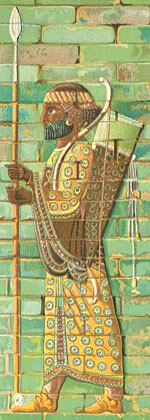
Detail of a frieze of
Persian archers from
the palace of Darius I at
Susa. Glazed siliceous
bricks, circa 510 BC.
Now in the Louvre.
Inv. No. AOD487.
[source] |
|
 |
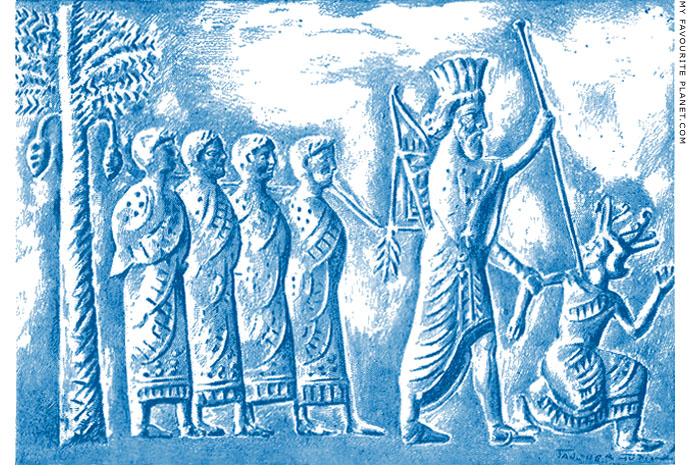
The "Zvenigorodsky seal", a chalcedony cylinder seal engraved with a scene showing
a Persian king killing a kneeling enemy with his spear in front of four prisoners. The king
has been variously identified as Darius I, Artaxerxes I, Artaxerxes II or Artaxerxes IIII.
Late 5th - early 4th century BC. Achaemenid dynasty. Acquired in Kerch,
Crimea, Ukraine around 1881. Drawing by Faucher-Gudin. [source]
Hermitage Museum, Saint Petersburg, Russia. Inv. No. GP 501.
Acquired 1930 from a private collection.
|
Source of drawings of Darius I and the Persian archer
Drawing of Darius I by Faucher-Gudin, from a photo by the French archaeologist Marcel-Auguste Dieulafoy (1844-1920).
The archer friezes were discovered by Dieulafoy and his wife Jane (1851-1916) during their excavation of Susa, Persia (Iran) in 1885-1886. Many of the artefacts they unearthed were shipped to France and are now in the Louvre. Drawing by Boudier, from a photograph taken in the Louvre by Faucher-Gudin.
Both drawings from:
Gaston Maspero (1846-1916), History of Egypt, Chaldaea, Syria, Babylonia, and Assyria, Volume 9 (of 12). Edited by A. H. Sayce, translated by M. L. McClure. Grolier Society, London. Undated (1906?). At Project Gutenberg.
Index page for all volumes (actually 13):
gutenberg.org/files/28876/28876-h/28876-h.htm |
|
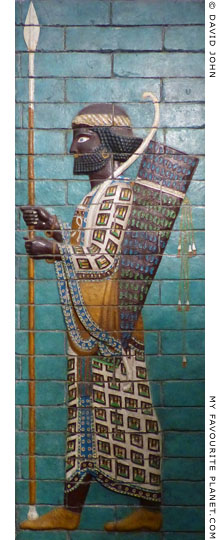
A cast of another enamelled
brick relief depicting a Persian
archer in the Louvre.
From the palace of Darius I
at Susa (Elam, today in Iran).
Barracco Museum, Rome.
Inv. No. MB 242. |
|
Photos, maps and articles: copyright © David John,
except where otherwise specified.
Additional photos: copyright © Konstanze Gundudis
All photos and articles are copyright protected.
Images and materials by other authors
have been attributed where applicable.
Please do not use these photos or articles without permission.
If you are interested in using any of the photos for your website,
project or publication, please get in contact.
Higher resolution versions are available on request.
My Favourite Planet makes great efforts to provide
comprehensive and accurate information across this
website. However, we can take no responsibility for
inaccuracies or changes made by providers of services
mentioned on these pages. |
| |
 |
Visit the My Favourite Planet Group on Facebook.
Join the group, write a message or comment,
post photos and videos, start a discussion... |
|
|
| |
|
|
| |
| |
 |
| |
 |
| |
 |
| |
 |
| |
George Alvanos
rooms in
Kavala's historic Panagia District
Anthemiou 35,
Kavala, Greece
kavalarooms.gr
|
| |
 |
| |
 |
| |
Olive Garden Restaurant
Kastellorizo,
Greece
+30 22460 49 109
kastellorizo.de
|
| |
Papoutsis
Travel Agency
Kastellorizo,
Greece
+30 22460 49 286
greeklodgings.gr
|
| |
|